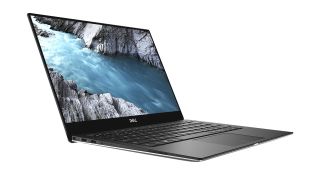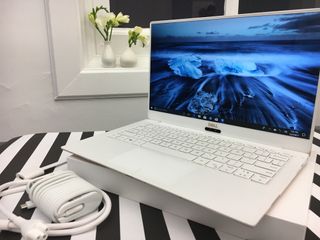Dell upgrades XPS 13 laptop with quad-core CPU options and slimmer design
A 13-inch laptop in an 11-inch body.

Dell didn't waste any time implementing Intel's 8th generation Core processors into its svelte XPS 13 laptop, adding the new quad-core Kaby Lake-R CPU options back in October. Now three months later, Dell has further refined the XPS 13 with an even slimmer profile
The new XPS 13 (9370) sports a tapered waistline that measures just 11.6mm at the back, and an even scanter 7.8mm at the front.
Like previous versions, it also has an 'InfinityEdge' display with 4mm borders on the sides and top. That's 23 percent thinner than the previous generation, resulting in an 80.7 percent screen-to-body ratio. Overall, the XPS 13 is just 302mm (11.9 inches) wide, despite having a 13.3-inch display panel. This means the webcam is still relegated to the unfortunate below-the-screen spot, but it's centered this time for a slightly more flattering angle.
Buyers can choose between a 1080p screen with or without touch support, or a 4K touch panel. The latter offers the best color reproduction with 100 percent coverage of the sRGB color space, versus 72 percent coverage on both 1080p options.
Unlike the XPS 13 9360 refresh, the new 9370 model sheds previous generation processor options and rolls exclusively with two of Intel's 8th gen chips—the Core i5-8250U and Core i7-8550U. Both are quad-core CPUs with HyperThreading support, the former clocked at 1.6GHz to 3.4GHz with 6MB of L3 cache, and the i7 part clocked at 1.8GHz to 4GHz with 8MB of cache.
Dell doesn't offer discrete graphics on the XPS 13, so hardcore gaming is out of the question (unless you add an external graphics box). The XPS 13 is more suited for portable productivity, though you could get away with some casual gameplay, depending on the game.

Up to 16GB of DDR3-2133 RAM is available for the XPS 13, along with up to a 1TB PCIe solid state drive.
The biggest gaming news, reviews and hardware deals
Keep up to date with the most important stories and the best deals, as picked by the PC Gamer team.
External connectivity consists of two Thunderbolt 3 ports, a USB 3.1 Type-C port, a headset jack, and a micro SD card slot.
For cooling, the XPS 13 relies on a pair of heatpipes and fans, and what Dell calls "Gore" thermal insulation. According to Dell, the XPS 13 is the first laptop to use Gore thermal insulation, which it claims offers thermal conductivity that is lower than air.
"It keeps your laptop cool while it works hard. Gore’s thermal insulation covers select areas of the heatpipes that cool the processor and graphics component. This keeps the surface of the system cool by helping to direct heat out of the device versus going through the device case. This not only lowers the surface temperature of your XPS, but also improves performance, enabling you to run your new XPS at higher levels of performance," Dell says.
The thermal insulation is apparently based on the same silica aerogels that have been used in extreme engineering environments, such as the Mars Rovers and Hyper Velocity Particle in the Stardust Probe. In other words, it's fancy stuff.
Dell also claims exceptional battery life—up to 19 hours and 46 minutes for the the 1080p SKUs, and up to 11 hours and 12 minutes for the 4K SKU. I had a chance to play with the previous iteration, the 9360 released in October, and battery life was indeed really good.
The new XPS 13 is available now at Dell.com, Microsoft.com and at Microsoft Stores. The standard version starts at $999.99, while Dell is also offering a Ubuntu-based developer edition with Linux preloaded for $50 cheaper.
Paul has been playing PC games and raking his knuckles on computer hardware since the Commodore 64. He does not have any tattoos, but thinks it would be cool to get one that reads LOAD"*",8,1. In his off time, he rides motorcycles and wrestles alligators (only one of those is true).
Most Popular






